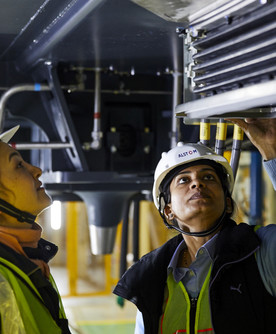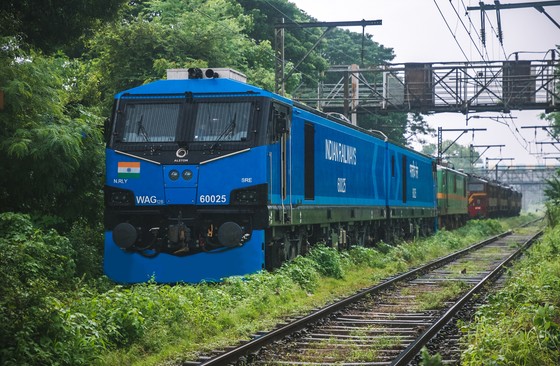
In the last 5 years, Alstom has contributed €438M in indirect & induced GDP to India’s economy, notes Ernst & Young report
In the last 5 years, Alstom has contributed €438M in indirect & induced GDP to India’s economy, notes Ernst & Young report

Press contact - India
Ankita Upadhyay
Send an email-
With an order backlog of €4.1B (end of March 2021) from its India operations, Alstom expects further growth in orders by 2025
-
Over 161,000 direct, indirect & induced jobs supported in India; aims to increase women employees to 28% by 2025
-
10x lesser CO2 emissions from Alstom’s mobility solutions compared to other modes of passenger and freight movement
29 September 2021 – Alstom, a global leader in sustainable and green mobility solutions, has released its first India Impact Report in partnership with Ernst & Young. The report captures the socio-economic contributions and ESG goals by Alstom in India until end of March 2021.
Commenting on the release, Alain SPOHR, Managing Director – Alstom India said, "India has always been a pivotal market for Alstom, and we continue to deepen this partnership by customizing mobility solutions for the country. We are delighted to share the impact/contribution of our presence in India via this report, especially in the areas of job creation, sustainability, and to the larger community. All this is reflective of the hard work and dedication of our people, and all our stakeholders in this extraordinary journey. We are committed to provide our unflinching support as an enabler in India’s growth story and help fulfil the government’s key ambitions of ‘Make in India’ and ‘Atmanirbhar Bharat’."
Cecile Texier, VP Sustainability & CSR, Alstom said, "For almost 30 years, Alstom has partnered with India in the modernisation and development of its transportation revolution, making it safer and more sustainable. And going forward, we aspire to positively influence the Indian market with our products and operations."

“For almost 30 years, Alstom has partnered with India in the modernisation and development of its transportation revolution, making it safer and more sustainable. And going forward, we aspire to positively influence the Indian market with our products and operations.”
Highlights on economic contribution
High localization & building a supply chain ecosystem
Alstom India buys €331 million worth of goods and services, among which 75% is made with Indian suppliers. Overall, the company has invested €142M (INR 12,556 M) locally in the last 5 years. In addition, the firm has conducted 21 technology transfers across Alstom locations, to suppliers and other partners.
Job creation and focus on Diversity & Inclusion
As of March 2021, Alstom had 7,634 direct employees in India. Additionally, the company has supported 71,340 indirect & 27,770 induced jobs across the country. The company is committed to improving its diversity ratio and plans to include 28% women in management, engineering & professional roles by 2025, while retaining its position as a Top Employer.
Remarkable reduction in CO2 emissions and proven focus on sustainability
10 X lesser CO2 emissions from Alstom built freight and metro trains vs other modes of transport.
In comparison to the high CO2 emissions from cars (79.5 gCO2/passenger.km), Alstom’s metro trains in India emit only 7.9 gCO2/passenger.kms. Similarly, the electric locomotives (e-Locos) deployed for high-speed freight transportation in India, emit 13.4 gCO2/ton.km of CO2, while goods trucks account for 92.3 gCO2/ton.kms.
Sustainable products and services
Alstom's eco-design approach focuses on continuously improving the sustainability of its solutions by tracking and minimising their environmental impact throughout their life cycles. For example, the mass of materials and components used in manufacturing rolling stock for Mumbai Metro Line 3 are 96% recyclable and 99% recoverable.
Decreasing the environmental impact of installations
Alstom is committed to limiting the environmental impact of its operations in India and worldwide. As a part of its Green Energy Strategy, Alstom is also investing in linking renewable energy production systems to its locations, such as at the Sri City facility, where 1 MW of solar energy generation capacity has been built.
The project will result in an annual reduction of 1,132 tonnes of CO2 emissions and reducing non-renewable energy consumption by 30% (by the end of 2021).
-
€438Min indirect & induced GDP to India’s economy
-
>161,000direct, indirect & induced jobs supported in India
-
28%increase in women employees by 2025
Outlook for Alstom India
Alstom will continue strengthening its contribution to socio-economic impact and ESG (Environmental, Social and Governance) goals.
By 2025, Alstom aims to reach 85% localisation on all domestic projects and increase the digitalization of processes by 20%.
The company will accelerate its move to maximum usage of Green/Renewal Energy in Industrial operations and 100% of newly developed solutions will be eco-designed.
Through its CSR initiatives, the company plans to reach 100,000 direct beneficiaries.
The expanded Alstom in Motion (AiM) 2025 strategic plan will focus on leveraging the group’s reinforced product lines and geographical presence, commit to accelerate smart and green mobility innovation with important R&D investments, and will extend its operational excellence efforts to a new scale.

The impact of Alstom in India
Read moreNotes to the editor
Methodology
The numbers and statistics given are for up until fiscal year 2020-2021. It offers a consolidated representation of former Alstom and Bombardier Transportation statistics. In some cases, an * is attached to the number presented. For those numbers specifically, the scope considered is the former Alstom legacy scope and the figure is computed over the 2019-2020 fiscal year.
The model used by EY to represent the socio-economic rippling effect within a given territory is based on the work of economist Wassily Leontief, who earned the Nobel Prize in Economics in 1973. This research is centred on the use of symmetric input-output tables to simulate the interdependence of all sectors of an economy. Moreover, since the model is linear, any economy of scale is ignored. By combining this modelling of the economy along with the employment intensity of each sector, it was possible to determine the indirect and induced socio-economic benefits. Those results are being derived from all Alstom’s activities worldwide and all global procurement. They are displayed at an Indian level but reflect the global supply chain of Alstom along with the goods and services exchange made between economic actors of all the countries in the world.
Explanation of some of the terms
Direct effects: The contribution of the activity/entity itself to the entire economy (e.g. in terms of the number of employees working for Alstom).
Indirect effects: To “produce” direct effects, a company needs to acquire goods and services (e.g. scrap metal, electricity, technical analysis services etc.) from suppliers. Those suppliers increase their production and hire additional staff to meet the demand of Alstom, thus generating indirect effects on jobs. Suppliers themselves cooperate with additional firms (their suppliers), creating a second-rank effect that is also part of the indirect effects generated by the company. The model adds up first-, second-, third-rank effects and so on, all along the supply chain.
Induced effects: Induced effects are the results of increased household expenses caused by the labour income of direct and indirect jobs. The induced effects are generated by employees spending within the business’ supply chain. Employee spending generates more demand in the economy, which leads to more production and, in turn, more profits, value-added (GDP contribution), employment, taxes, and so on.

